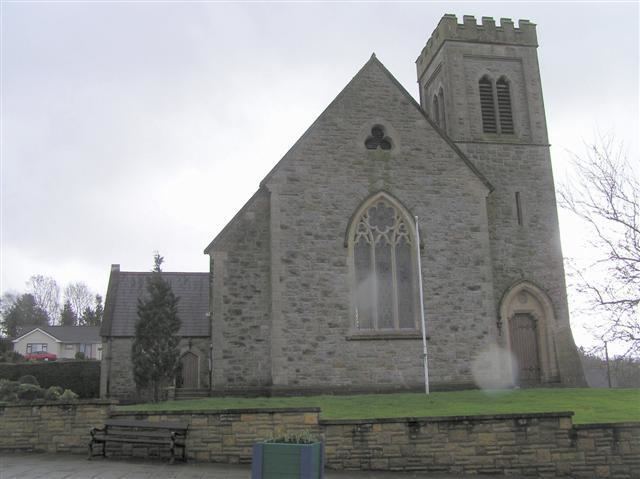Population 1,340 (2001 Census) Sovereign state United Kingdom Local time Wednesday 1:28 AM Province Ulster | Irish grid reference H260528 Post town ENNISKILLEN Dialling code 028 | |
 | ||
Weather 3°C, Wind W at 5 km/h, 92% Humidity UK parliament constituency | ||
Ballinamallard or Bellanamallard (from Irish Béal Átha na Mallacht, meaning "ford-mouth of the curses") is a small village and townland in County Fermanagh, Northern Ireland. It had a population of 1,340 people in the 2001 Census. It lies to the north of Enniskillen and is situated within Fermanagh and Omagh district.
Contents
- Map of Ballinamallard Enniskillen UK
- History
- Economy
- Transport
- Sport
- People
- 2001 Census
- 2011 Census
- References
Map of Ballinamallard, Enniskillen, UK
The village has won several "best kept village" titles, and has a fountain to mark the honour. There has been only one local primary school: Ballinamallard Controlled Primary School, since the other, Shanmullagh Primary School, closed in August 2008.
History
About 450AD Magheracross said to have been founded by St Patrick and about 550 St Columba passed thorough Ballinamallard. The first records of the parish itself were in 1492 with Terence Macgillacossgli (Cosgrave) is recorded as vicar of Magheracross and Derrybrusk, Maghercross was at that time part of Derryvullen parish.
In 1500 two Maguire princes were ambushed by the O'Neills at Ballinamallard in their conflict and in 1539 the Original Magheracross church destroyed by fire
1593 saw the start of Hugh O'Neill's war that resulted in the Flight of the Earls in 1611. Following which Henry Folliot of Pyrton in Wiltshire, was granted the Manor of Drumchine (later Newporton) including 1,500 Irish acres through Magheracross parish. He built Castle Murray and imported tenants from the Scottish Borders between Dumfries and Carlisle who were fleeing the union of England and Scotland and the consequent pacification of the previously lawless area around Anglo-Scottish border under James I that was taking place at that time.
By 1622 there were 20 houses in Ballinamallard and the Church "standing but not repaired within". In 1629 the old graveyard at Kilskeery and Magheracross was officially united with Kilskeery parish.
Religion was important through the 18th century. In 1704, Rev N Browne, Rector of Kilskeery, translated the Prayer Book into Irish. In 1766 Magheracross Parish split from Kilskeery and in 1769 John Wesley visited the area bringing Methodism. Coa Chapel was built in 1770. Ballinamallard Church of Ireland was built in 1785 and the Methodist Hall was constructed in 1800. The Present Church of Ireland was built in 1844.
The 18th century also saw non-religious developments, Magheracross House was built in 1740 and the Ballinamallard bridge was built in 1750. 1783 saw the Repeal of Poyning's Law and the Birth of Orange Peggy.
In the early 20th century, thousands of Cooneyites or "Dippers", followers of Edward Cooney and William Irvine, flocked to religious conventions at Crocknacrieve House near Ballinamallard. Converts were baptised by immersing them in Lough Erne or tributary rivers, events which attracted large crowds and international attention.
Economy
Many family businesses are located in Ballinamallard. In the 1970s the Development Association initiated some useful projects. The old Great Northern Railway station was restored to become the Rascal’s PlayStation, a purpose-built child care centre, while the Commons was transformed into a children’s playground and industrial units were established on the Enniskillen road.
Ballinamallard’s best known family are the Fishers, whose firm, Fisher Engineering, has brought substantial employment to the village. The company, which specialises in agricultural engineering and building construction, was founded by the late Thomas Fisher when he returned from World War II. Today Fishers are one of the foremost steel construction firms in the British Isles servicing such projects as the Waterfront Hall and the Odyssey Arena, both in Belfast.
Transport
Ballinamallard railway station opened on 19 August 1854, but was finally closed on 1 October 1957.
Sport
People
2001 Census
Ballinamallard is classified as a village by the NI Statistics and Research Agency (NISRA) (i.e. with a population between 1,000 people and 2,250 people). On Census day (29 April 2001) there were 1,340 people living in Ballinamallard. Of these:
For more details see: NI Neighbourhood Information Service
2011 Census
On Census Day 27 March 2011, in Ballinamallard Ward, considering the resident population:
99.27% were from the white (including Irish Traveller) ethnic group; 21.69% belong to or were brought up in the Catholic religion and 75.17% belong to or were brought up in a 'Protestant and Other Christian (including Christian related)' religion; and 66.13% indicated that they had a British national identity, 14.11% had an Irish national identity and 29.16% had a Northern Irish national identity*.
On Census Day 27 March 2011, in Ballinamallard Ward, considering the population aged 3 years old and over:
5.21% had some knowledge of Irish; 5.97% had some knowledge of Ulster-Scots; and 1.37% did not have English as their first language.
